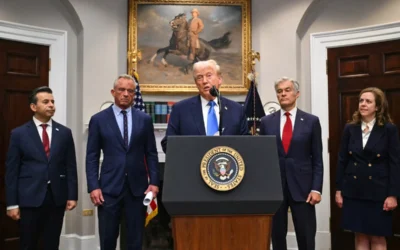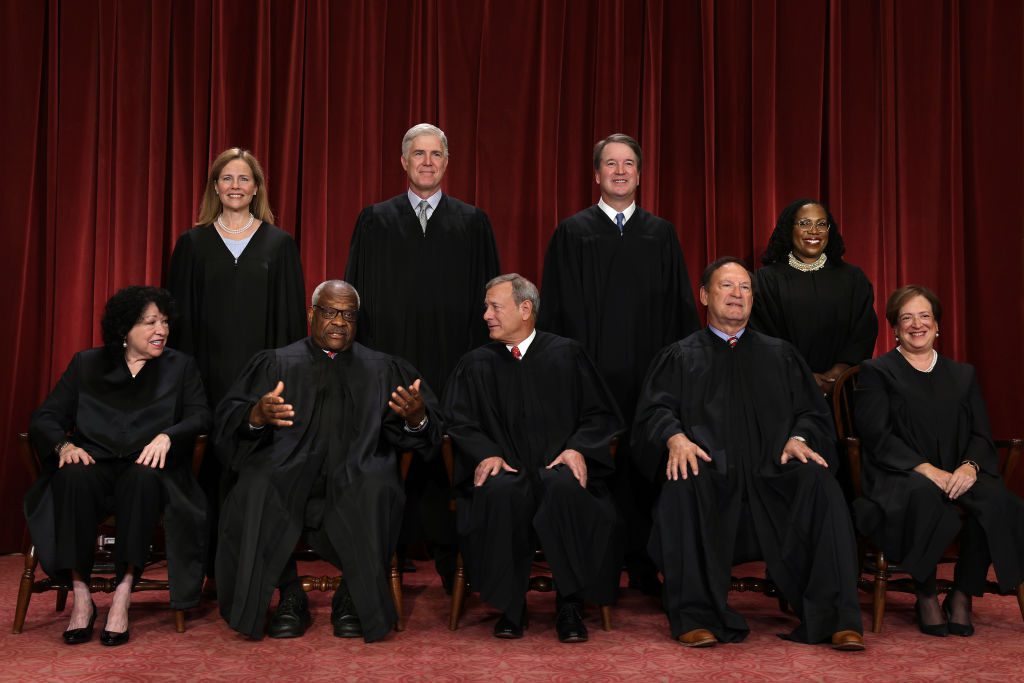
United States Supreme Court (front row L-R) Associate Justice Sonia Sotomayor, Associate Justice Clarence Thomas, Chief Justice of the United States John Roberts, Associate Justice Samuel Alito, and Associate Justice Elena Kagan, (back row L-R) Associate Justice Amy Coney Barrett, Associate Justice Neil Gorsuch, Associate Justice Brett Kavanaugh and Associate Justice Ketanji Brown Jackson pose for their official portrait at the East Conference Room of the Supreme Court building on October 7, 2022 in Washington, DC. The Supreme Court has begun a new term after Associate Justice Ketanji Brown Jackson was officially added to the bench in September. (Photo by Alex Wong/Getty Images)
The US Supreme Court has, shall we say, made news this year. Here’s an approachable explainer to some of their top rulings of the term, and how they impact clean air, workplace safety, health insurance, and the general quality of life for all Americans.
The US Supreme Court headed out on their summer recess in early July, and they’ll be back in session on the first Monday of October. Which means we can stop holding our breath for a second and do a quick review of what changed for our country as a result of rulings they made over the 2023-2024 term.
The Court made 62 rulings between October 2023 and July 2024. In this review, we give you the quick hits for a handful of them, then do a reasonably good job of breaking down three of the whoppers (do the names Jarkesy, Chevron, and Trump ring a bell?) that left a lot of legal scholars clutching their pearls.
Quick Hits
City of Grants Pass v. Johnson (June 2024, 6-3 ruling)
tl;dr: The Supreme Court decided that US cities out west can “criminalize unhoused people for sleeping outside even when they lack access to shelter.” This means homeless people can be fined (and even jailed) for sleeping and/or camping in public places, including in parks and on the street. The case stems from Grants Pass, Oregon, where homeless people have been prohibited from sleeping or camping in public places for years. In that city, they’re also banned from “using a blanket, pillow, or cardboard box for protection from the elements.” Think that sounds cruel? The SC disagrees. To read more, click here.
Snyder v. United States (June 2024, 6-3 ruling)
tl;dr: The Supreme Court decided that gifts or payments made to state or local officials after they implement political or social actions don’t violate the law. If you want to bribe a public official, wait until after they do what you want to pay them. To read more, click here.
Murthy v. Missouri (June 2024, 6-3 ruling)
tl;dr: The Supreme Court decided that the government has permission to “call on tech companies to remove falsehoods” on social media as a way to prevent the spread of misinformation online. Basically, the SC is saying that federal officials can urge “private companies to block or remove users” they believe are in violation of the First Amendment without violating Americans’ right to free speech. To read more, click here.
United States v. Rahimi (June 2024, 8-1)
tl;dr: The Supreme Court ruled that a law “preventing anyone placed under a domestic violence restraining order from possessing a gun” is constitutional. (Justice Clarence Thomas was the lone dissent.) In other words, the lifesaving law protecting domestic violence survivors and others from the threat of gun violence from abusers still stands. To read more, click here.
For a full list of major Supreme Court decisions from 2024, click here.
The Whoppers
SEC v. Jarkesy: By agreeing that a shady money manager should have gotten the jury trial he wanted, the SC strips federal agencies of their power.
The case: Securities and Exchange Commision (SEC) v. Jarkesy
When: June 2024
The ruling: 6-3 in favor of George Jarkesy
tl;dr: This case started as a request for a jury trial from a hedge fund manager accused of defrauding his investors. It ended with six conservative justices breaking 170 years of legal precedent to strip potentially dozens of government agencies of their power to protect Americans.
Takeaway quote: “The American People should not mistake judicial hubris with the protection of individual rights.” – Supreme Court Justice Sonia Sotomayor, in her dissenting opinion
What happened: George Jarkesy is a hedge fund manager and conservative talk show host who’s donated money to Republican candidates, spread conspiracy theories about former President Barack Obama, and developed a radio platform on the idea that government agencies have too much power.
In 2013, Jarkesy was charged with defrauding investors by the Securities and Exchange Commission, commonly referred to as the SEC. The SEC was created in the aftermath of the Wall Street Crash of 1929 to protect investors from misconduct and unfairness in the market. Like with most federal agencies, the person presiding over Jarkesy’s original case was an administrative law judge. That’s an independent official who hears a case involving an agency within the federal government and hands down a ruling. This system has been in place since 1946.
Administrative law judges commonly preside over civil charges like Jarkesy’s. A civil charge is essentially a case involving a dispute between people or organizations—in contrast to a criminal charge, which is a case alleging a violation of criminal law.
That’s important because it’s how the US Supreme Court got involved.
The US Constitution guarantees that defendants in criminal cases are entitled to jury trials. But because federal regulating agencies—like the SEC, the Environmental Protection Agency (EPA), the Food and Drug Administration (FDA), the Social Security Administration (SSA), and the Occupational Safety and Health Administration (OSHA)—are watchdogs over an incredible number of employers, organizations, and corporations, giving full jury trials to the civil cases these agencies use to protect Americans from wrongdoing would be impossible.
When an administrative law judge found George Jarkesy guilty of committing fraud against investors, Jarkesy appealed on the grounds that he should have had the right to a jury trial. And when the six conservative justices on the US Supreme Court agreed, their decision not only reversed 170 years of judicial precedent, it also put miles of red tape in front of any American hoping the federal government will be able to live up to its promises to protect their right to join a union, to get the Social Security benefits they’re owed, or to stay safe at work. In short, the Court made it much, much harder for the government to help Americans live better, safer lives.
Nail in the coffin: In her dissenting opinion, progressive justice Sonia Sotomayor wrote that “the constitutionality of hundreds of statutes may now be in peril, and dozens of agencies could be stripped of their power to enforce laws enacted by Congress.”
The federal government simply doesn’t have the financial and physical resources to hear every civil suit in a jury setting. Without the ALJ requirement, federal agencies will lose much of their ability to impose penalties against defendants accused of fraud or wrongdoing by those agencies. In short, an investigative report from Slate succinctly stated last month, “the decision will chill enforcement throughout the executive branch, allowing more white-collar criminals, polluters, abusive employers, and other malefactors to slip through the cracks.”
And in a US Policy and Regulatory Alert issued earlier this month, attorneys from K&L Gates summarized concerns about how Jarkesy could wreak havoc for environmental protections designed to ensure safe, healthy water and air for Americans.
“The Environmental Protection Agency (EPA) regularly uses administrative proceedings to pursue violations of various environmental laws (e.g., Clean Air Act, Clean Water Act), a practice that may come into question under Jarkesy. And as the dissenting Justices warned, certain civil penalties may no longer be enforceable at all,” the alert cautioned.
Justice Sotomayor’s dissent went on to call out the conservative justices on the Court as acting outside of the country’s best interests: “The American People should not mistake judicial hubris with the protection of individual rights.”
Chevron: The Court removes a thorn in conservative sides—the idea that experts are necessary to interpret laws
The cases: Loper Bright Enterprises v. Raimondo, and Relentless v Department of Commerce
When: June 2024
The ruling: 6-2 (Loper), 6-3 (Relentless)
tl;dr: Oil billionaires, rejoice—this major change to a former ruling says courts, not subject matter experts, know best when it comes to regulating the health, safety, and welfare of Americans and the environment. Turning their backs on scientists, labor organizations, and environmentalists, the Supreme Court’s six conservative justices overturned the 1984 Supreme Court’s ruling requiring experts to interpret laws dealing with major regulations.
Fun fact: One of the groups behind the case was funded by oil mogul Charles Koch.
Takeaway quote: “Let’s call this Supreme Court ruling on Chevron what it is: a power grab by the far-right to benefit the wealthy and well-connected.” – Massachusetts Sen. Elizabeth Warren, on social media
The short version: When considering a bill about, say, new clean water regulations Congress may now defer to the opinion of a federal judge (who isn’t necessarily an expert on the subject) instead of hearing input from hydrologists and other scientific experts employed by the EPA. Ditto for regulations on daily tasks we complete with relative safety thanks to the protection of the agencies that were previously the main decision makers in these instances.
The long version: The Chevron doctrine (or Chevron deference, as it’s also referred to) was a legal precedent decided by the Supreme Court in 1984 during the Chevron U.S.A., Inc. v. Natural Resources Defense Council, Inc. case. Even though it was decided in 1984, the issue at the center of that case actually stemmed from earlier instances in 1977 and 1981.
Back in 1977, Congress passed a bill amending the Clean Air Act of 1963. This amendment officially required any project creating a major source of air pollution to go through the EPA’s then-recently approved “new-source review.” (This is a fancy way of saying that the EPA put together a new review that would help ensure air quality safety by limiting pollution sources.) At that time, the EPA considered single machines, like a boiler, to be “sources” subject to the new review.
Fast forward slightly to 1981, when the EPA changed their meaning of the term “source” under then-President Ronald Reagan’s administration. The change said that any “source” subject to review would mean entire factories or plants, and would no longer apply to single machines. In changing the meaning of what the word “source” applied to, the review process changed as well.
A factory or plant only needed to go through that “new-source review” process if it was increasing total air-pollution emissions for the entire factory/plant. Why does that matter? Because it allowed companies to take advantage of a review loophole. If a company wanted to create a new project that would result in air pollution, they could tweak other things within the plant to reduce emissions by the same amount. Basically, as long as the air pollution amounts evened out, they could bypass the EPA review.
The Natural Resources Defense Council wasn’t happy about this, because the loophole meant that air pollution wasn’t actually lessening—it was staying the same. They filed a petition for review in 1981 with the US Court of Appeals for the District of Columbia. In the petition, they challenged the legality of this new interpretation. The DC Circuit ruled in their favor in 1982. Fun fact: Ruth Bader Ginsburg, then a US circuit judge, was one of the judges who ruled that the EPA’s new interpretation of the term “source” was invalid.
After this happened, the Chevron Corporation (which was impacted by the EPA’s regulation) appealed the DC Circuit’s decision to the Supreme Court, which is how we eventually wound up at the 1984 decision to create the Chevron deference.
Essentially, the 1984 Chevron decision stated that if Congress passed a law that lacked specificity, courts must apply deference (in other words, give Congress the benefit of the doubt) and call in federal agency experts to help determine how to best apply that law.
Federal agencies like the EPA are part of the executive branch of government, meaning they must answer to the President of the United States. They’re also, as you might guess, staffed by experts in their respective fields (not elected officials).
Many conservatives argued that the Chevron doctrine gave those non-elected experts too much power over what corporations could and could not do. According to the New York Times, the 2024 effort to strike down Chevron was led primarily by conservative legal funders and activists, as well as Republican attorneys general. Many of these people have ties to bigger corporations… which, in turn, happen to have ties to former President Donald Trump.
Several important regulations related to everything from the Affordable Care Act to the Fair Labor Standards Act—which established the federal right to a minimum wage—have been decided based on the precedent the Supreme Court originally established in 1984’s Chevron. However, the New York Times notes that Chevron hasn’t been popular with Supreme Court justices in recent years, and hasn’t been invoked since 2016. Before that, it had been used to decide cases on at least 70 separate occasions. (Side note: Recall that President Donald Trump won the 2016 election, and appointed three ultra-conservative justices to the Supreme Court during his term.)
The decision by the current Supreme Court—which includes, perhaps ironically, a majority of “originalists”—to undermine the doctrine opens the door for weakened regulations related to climate change, carbon emissions, labor rules (including overtime and minimum wage), FDA approval standards, and even health insurance operations.
Speaking with the New York Times, Lisa Heinzerling, an administrative law expert at Georgetown University, said, “If Americans are worried about their drinking water, their health, their retirement account, discrimination on the job, if they fly on a plane, drive a car, if they go outside and breathe the air—all of these day-to-day activities are run through a massive universe of federal agency regulations.”
To build off what Heinzerling is saying: When considering a bill about new clean water regulations, Congress may now defer to the opinion of a federal judge (who isn’t necessarily an expert on the subject) instead of hearing input from hydrologists and other scientific experts employed by the EPA. Ditto for regulations on daily tasks we complete with relative safety thanks to the protection of the agencies that were previously the main decision makers in these instances.
Nail in the coffin: Though the exact impact of this decision remains a mystery until these regulations start to trickle down through the courts, it sets an uncertain precedent for the future.
“This is a seismic shift. Congress passes laws and then federal agencies use their deep knowledge and expertise to implement them,” said Sen. Amy Klobuchar (D-MN) in a statement. “In overturning decades of settled law, this extreme Court has given itself the power to second guess even the most complex regulatory decisions. This decision will result in chaos and undermine our ability to protect the health and safety of all Americans.”
Trump v United States: The president is above the law (cue Nixon rolling over in his grave)
The case: Trump v. United States
When: July 2024
The ruling: 6-3
tl;dr: Trump v. United States shocked many Americans because it pretty much gives former President Donald Trump complete immunity from being prosecuted for his alleged criminal behavior. And it sets a potentially dangerous precedent for what he’s allowed to get away with if he’s reelected. The decision gives future presidents “broad immunity” from criminal prosecution. This means they’re allowed to commit a variety of crimes—both significant and petty—without being prosecuted by the law, as long as they’re using their official powers as president to commit those crimes. (That’s your cue, dangerous leaders of countries or factions who want to bribe the President of the United States.)
Takeaway quote: Ian Millhiser, senior correspondent at Vox, wrote that the Supreme Court’s decision “ensures that, should Trump return to power, he will do so with hardly any legal checks. Under the Republican justices’ decision in Trump, a future president can almost certainly order the assassination of his rivals. He can wield the authority of the presidency to commit countless crimes. And he can order a subordinate to do virtually anything. And nothing can be done to him.”
What happened: The decision in Trump v. United States extends from the former president’s ongoing federal trial to determine whether he interfered with the 2020 election, and whether he played a role in the Jan. 6, 2021 attacks on the US Capitol.
Prosecutors in that trial are alleging that Trump pressured officials to reverse the 2020 election results, and that he also willingly spread misinformation about election fraud. Additionally, they’re alleging that the former president used the Capitol riot to, in essence, delay President Joe Biden’s victory in an effort to retain power. In that trial, the former president has been charged with four criminal counts. TBD as to when the trial will continue.
The 6-3 ruling in Trump v. United States basically says that presidents have “broad immunity” from criminal prosecution. Full stop. Hold on, what? Yes, the SC ruling more or less says that presidents can commit crimes without being legally held responsible for said crimes as long as they were using the official powers of the office of the presidency to commit them.
Chief Justice John Roberts (and his conservative majority) reached a few…let’s call them conclusions you’re going to want to know about:
The first conclusion: When the president takes any action under the authority given to them by the Constitution, their authority is considered “conclusive and preclusive” and they cannot be prosecuted for that action—even if it’s criminal.
That means the president could, hypothetically, order a member of Seal Team 6 to assassinate a political rival and not be held legally responsible for the assassination.
Progressive Justice Ketanji Brown Jackson was one of three Supreme Court justices who ruled against this decision. In her dissenting opinion, she stated: “From this day forward, Presidents of tomorrow will be free to exercise the Commander-in-Chief powers, the foreign-affairs powers, and all the vast law enforcement powers enshrined in Article II however they please—including in ways that Congress has deemed criminal and that have potentially grave consequences for the rights and liberties of Americans.”
The second conclusion: This immunity additionally applies in certain circumstances when the president uses authority that isn’t mentioned in the Constitution, such as while engaging in private conversations with their subordinates (AKA someone who’s in a lower position than them). Chief Justice Roberts wrote that this is “presumptive immunity” from criminal prosecution because the president would be acting “within the outer perimeter of his official responsibility.”
If the president were to order their subordinate to do something illegal, the president wouldn’t be held responsible for that crime if it could, in theory, be included in the “outer perimeter” of their official responsibilities. All of this is very, very broad and would end up being determined, or so it seems, on a case-by-case basis.
Up in the air: One small caveat here is that the president can still be prosecuted for “unofficial acts.” So, in this hypothetical case, if a president were to shoot and kill an opposing candidate themselves, versus having Seal Team 6 assassinate the rival, then the president would probably be prosecuted for the murder. This is where the emphasis on broad in “broad immunity” would come into play.
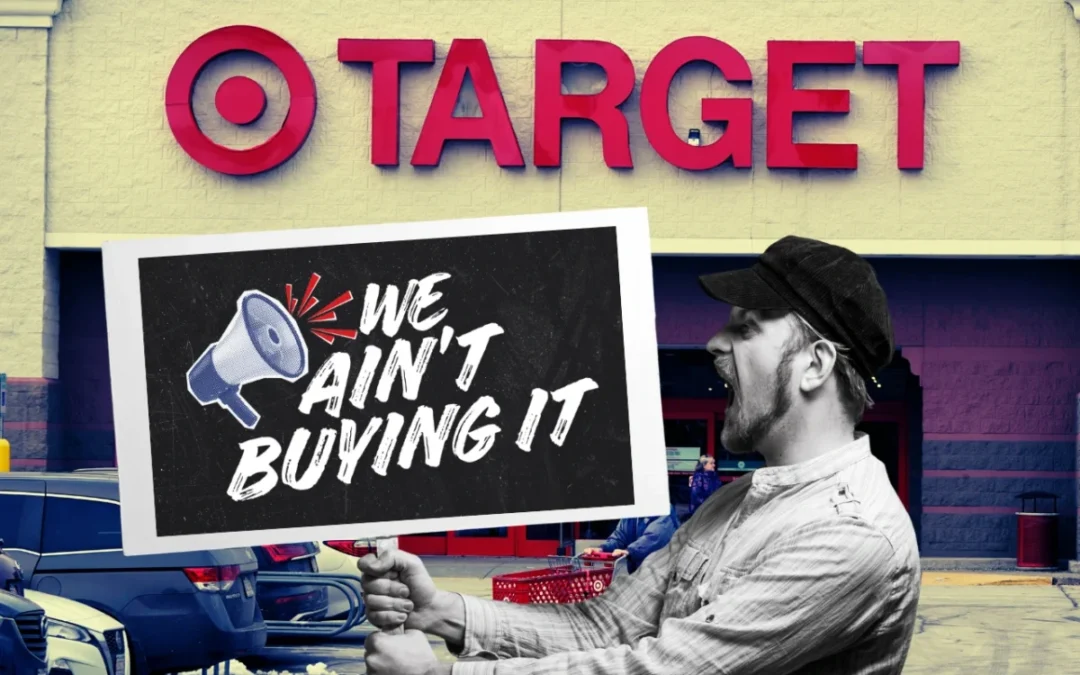
Why some Michiganders are boycotting Target, Home Depot, and Amazon on Black Friday
The nationwide “We Ain’t Buyin’ It” campaign is asking Americans to stop shopping at Amazon, Home Depot, and Target for five days—from Thanksgiving...

Michigan officials say Trump’s trade war is raising prices. Voters say they feel it.
A new state analysis details widespread cost increases tied to tariffs, as Michigan voters report feeling the strain in their grocery bills, housing...
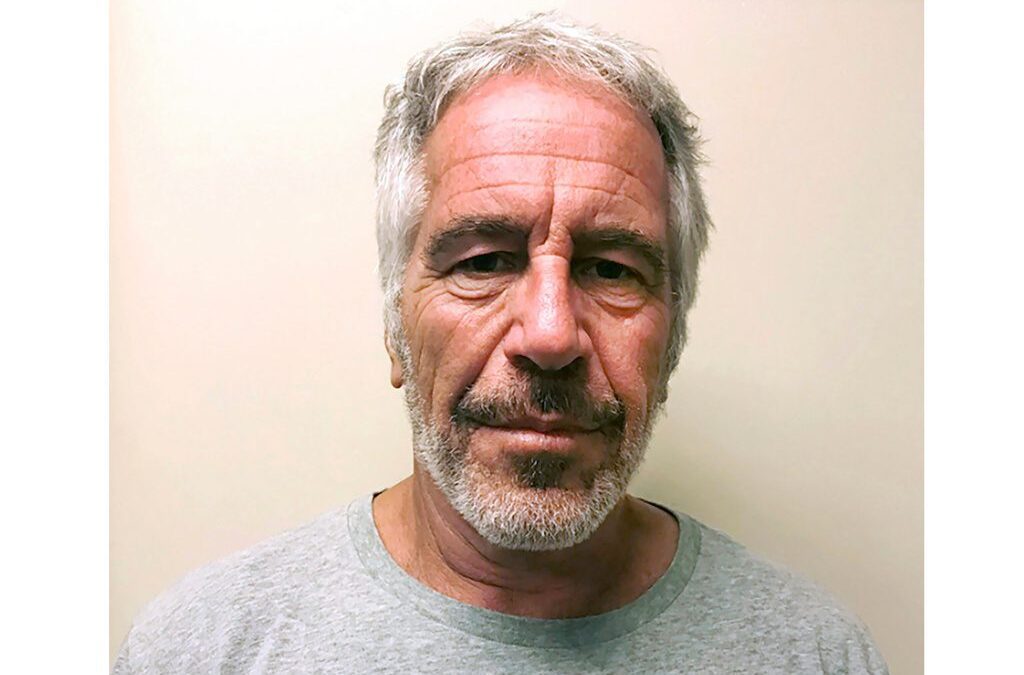
Epstein email says Trump ‘knew about the girls,’ but White House says release is a Democratic smear
WASHINGTON (AP) — The sex-offending financier Jeffrey Epstein wrote in a 2019 email to a journalist that Donald Trump “knew about the girls,"...

What’s going on with SNAP benefits in Michigan?
About 1.4 million Michiganders are feeling the pinch as the federal government shutdown stalls food assistance payments and leaves food banks...
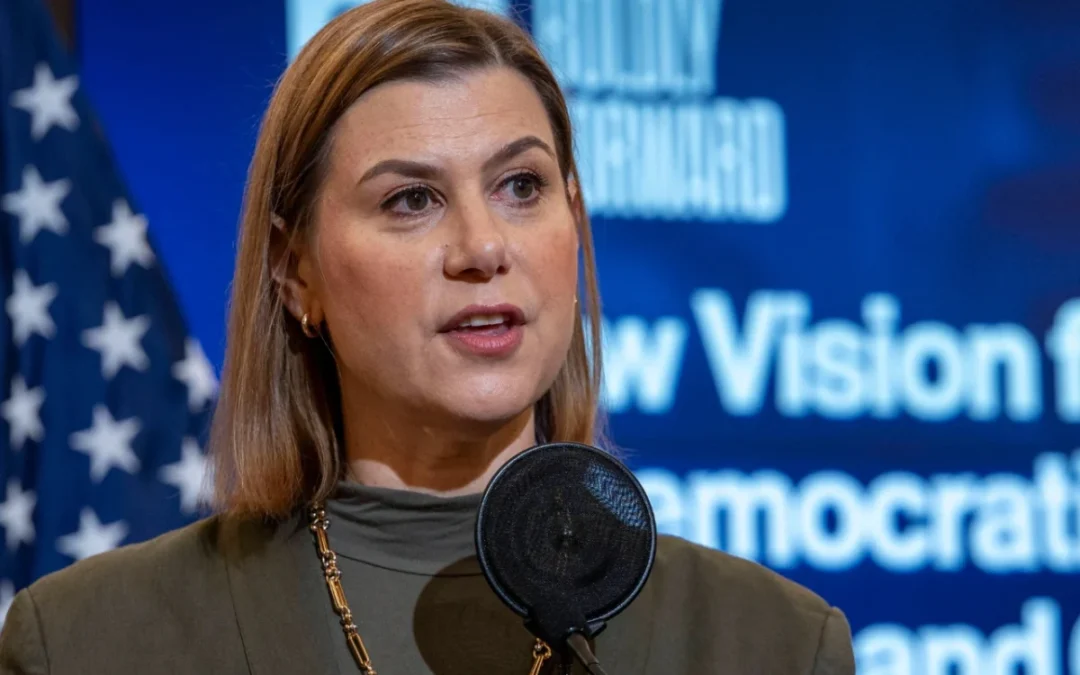
Elissa Slotkin raises alarm over secret Trump-era terrorist group designation list
BY KATHERINE DAILEY, MICHIGAN ADVANCE MICHIGAN—US Sen. Elissa Slotkin (D-Holly) called a new policy enacted by President Donald Trump...





